Birth Of The Modern Furniture Industry 1870-1895
by Russell Bienenstock
Everyone has heard stories about a couple of guys who founded a company with nothing more than a few bucks and a good idea. They worked tirelessly in their garage turned work-place, eventually achieving unimaginable success.
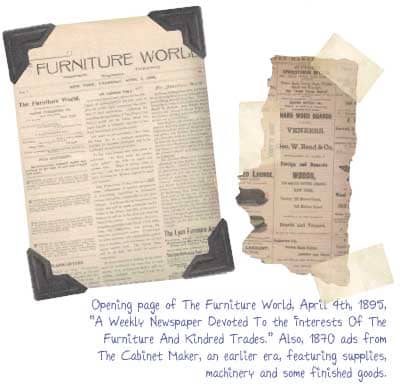
We will celebrate our 140th year of furniture publication, starting with this issue, by telling these kinds of stories and much more. Furniture World will look at the furniture industry through the lens of history, and focus on the ideas, struggles and successes of furniture men and women, manufacturers, importers, reps and retailers.
Additional information from oral interviews conducted by the American Furniture Hall of Fame and historical accounts collected from our retail readers will also be included in editorial features run throughout 2010. We hope that you enjoy this effort.
So, what better place is there to start, than with the founding story of America’s first furniture publication, Furniture World Magazine? Furniture World, first published by John Towse under that name in 1895, traces its origins back to “The Cabinet Maker” founded in 1870. This predecessor publication was later purchased by Furniture World. Many of the details are lost to history, but the basic story line follows.
“The Cabinet Maker” wasn’t started by “two guys in a garage.” There were actually three, Ludwig Bauman, William Sherer and Levi Heywood.
The three founders were highly successful and well established in the furniture industry by 1870. William Sherer was President of Paine’s of Boston, founded in 1835. Paine’s Furniture was both a manufacturer and retailer operating out of a ten story Building in the Back Bay section of Boston. The top four floors were devoted to furniture manufacturing. The rest of the building showcased furniture sourced primarily from New England and Grand Rapids.
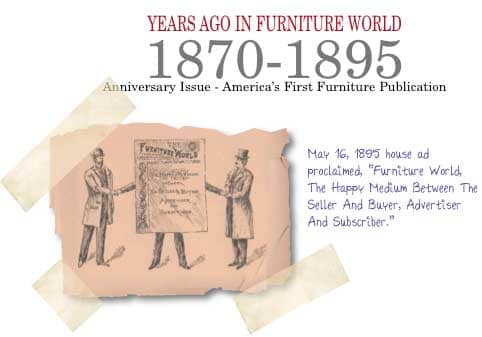
Ludwig Bauman was President of Ludwig Bauman Company of New York, founded in 1858. In 1950, “Furniture World Magazine” published a profile of this furniture retailer that in 1947 grossed more than $15,000,000 (about 400 million in 2010 dollars). The article noted that in addition to helping to found Furniture World, “Many of the progressive ideas Mr. Bauman fathered back in 1870 have been adopted throughout the retail industry today. An outstanding innovation which he developed was the charge account system, he himself being the first furniture dealer in the United States to use the system successfully and build it to major proportions.”
The third member of the founding team was Levi Heywood, senior partner in what was then Heywood Brothers & Company, the forerunner of famed manufacturer Heywood Wakefield.
In 1870, Ulysses S. Grant had been in the White House for about a year. The US Government had just recognized the new French Republic, and in England, the people mourned the recent death of Charles Dickens.
About this time furniture making was becoming an important industry in America as mass production techniques replaced workshop production.
Prior to 1870, the “official” furniture industry publication was Iron Age. In those days Iron Age covered a number of industries including just a few pages in each issue on furniture. At best, “Iron Age” devoted meager resources to an industry that was growing rapidly as the industrial revolution progressed. Levi Heywood, the spokesman for the founding group noted that the time had come for the furniture industry to have a publication of its own. He believed that any consumer good or activity that vied for consumer dollars was competition for the furniture industry, and that a publication representing our industry should have in its advertising and text, the story of furniture as its main content. Above all Mr. Heywood said, “waste is akin to sin,” and, “the new publication must go to only those people to whom a cabinetmaker can hope to sell his wares: and if possible, no others.”
The three men appointed Henry J. Symonds to edit and publish their new publication as a weekly newspaper. Written into the original bylaws, was the condition that the publication would deal only with furniture. One by one, the founders withdrew their support as the publication grew and prospered.
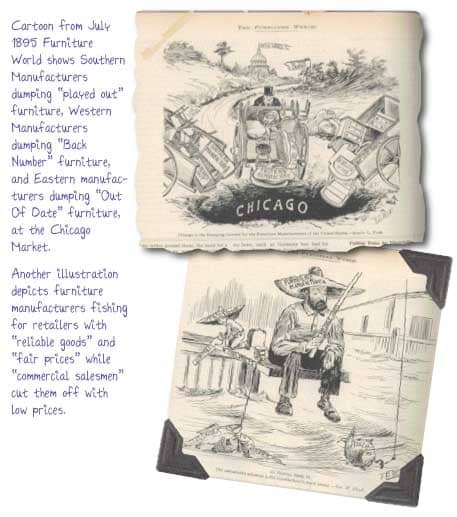
TRANSITION
Between 1870 and 1895, the furniture industry transitioned from creating its products in cabinet making shops, in favor of mechanized factories. This was a continuation and an acceleration of a trend started in the US three quarters of a century earlier with the founding of the Hitchcock Chair Company in 1818. The excellent book “Grand Rapids Furniture,” notes that, “This company adapted for furniture the assembly-line production of standardized parts, and the division-of-labor principles already used by other New England Factories that made guns and clocks.” Hitchcock chair was especially well known and at its peak produced 15,000 chairs per year. The factory continued production until 2006.
As the industry matured, manufacturing moved westward. By 1870, the states of Illinois, Michigan, Indiana and Ohio were becoming important furniture manufacturing centers.
FURNITURE WORLD
RESPONDS TO CHANGE
John M.L. Towse started publishing New York based Furniture World in response to these changes. His publication would later acquire the rights to The Cabinetmaker, but in 1895 there was an open and public confrontation with its editor J. Henry Symonds, who wrote this note to the Postmaster General just before the first issue of The Furniture World was published. “Dear Sir, A paper is to be published in this city this week, which it seems to me ought not to be admitted to the mails as second class matter. It is to be called The Furniture World, and fourteen of its fifteen owners are furniture dealers, and the object of it is to trade advertising space for goods for the benefit of these fourteen dealers. Papers of this character are a serious detriment to legitimate trade publications.”
Mr. Towse replied that the, “Object of The Furniture World is not to trade advertising space for goods; and it never had that intention; it does not do it , and furthermore, it never will do it.”
The initial staff included G. H. Langworthy listed as Secretary. She would eventually become editor and owner of the publication. Mrs. Langworthy, nicknamed the “Mother Angel” of the furniture industry, would in turn, hire N.I. (Sandy) Bienenstock in 1922 to put the publication on sound financial footing following an incident involving an embezzler, also the mistress of a major New York retailer. Mr. Bienenstock would eventually purchase Furniture World, establish the Bernice Bienenstock Furniture Library in High Point and be inducted into the American Furniture Hall of Fame as a Member.
In 1895, Furniture World turned away from articles about furniture production and cabinet making materials and toward sales and marketing topics. These dealt primarily with business opportunities, editorial commentary, and information on weekly market conditions in major furniture producing and consuming centers such as Philadelphia, Grand Rapids, Chicago, Cincinnati, and Washington.
In the April 4, 1895 edition, John Towse wrote, “The Furniture World will be a newspaper, independent in opinion, progressive in everything pertaining to nineteenth century journalism, trustworthy in its news columns. It will not only be inexpensive, but bright, and will be made a welcome weekly visitor to the factory and office of the manufacturer as well as to the store and counting room of the retailer… Its career will be unbiased and unprejudiced against men or markets, with friendship for all and malice toward none. The United States will be its field, the world its source of inspiration.”
Judging by letters received from subscribers and advertisers, The Furniture World was well received. E. B. Reve wrote, “Enclosed find a money order for $2, in payment for my subscription. I congratulate you on the snap and vim in the first issue. The child was born with all its hair and teeth. If it gets better as it gets older, it will be a corker.”
FURNITURE MARKETING 1870-1895
The formation of the furniture marketing system we know today was coincident with the founding of Furniture World.
In the latter part of the 19th century, American furniture manufacturers relied on traveling salesmen known as “drummers,” to sell their goods to stores, consumers and to buyers furnishing structures such as office buildings and hotels. Without the benefit of modern photography or the ability to carry samples, these early manufacturers’ representatives were severely disadvantaged. Furniture World reported that manufacturers and buyers were not always satisfied with the performance of the drummers who, they said, might “palm off” inferior products on the customer, creating a bad reputation for the manufacturer, or work only for a short period and then go into competition with their former employers.
Boston and New York were early centers of furniture production. In Boston, for example, furniture manufacturers took their products by boat to nearby towns and auctioned them off on the dock. Sales were not always brisk, causing goods to often be sold at large discounts. Necessity being the mother of invention, small groups of Boston and New York producers decided to try to get buyers to come to them.
By 1870 a movement was underway to try to bring buyers to the goods instead of bringing goods to buyers. Throughout the 1870s and 1880s, furniture manufacturers held small cooperative displays, mostly in warehouses. This solution proved less than satisfactory and expensive for buyers who had to travel long distances to view goods without the advantages of modern roads or “horseless carriages.”
As today, women were not well represented in the ranks of furniture reps. In an 1895 Furniture World article, the wife of a drummer wrote, “Life on the road means dwarfing oneself; it means unfortunate conditions for the highest development, mentally and morally… and so to all women wishing to be ‘real drummers’ I can honestly say, in the light of my own long experience, Don’t.”
Commenting on this early system, William M. Bangs would later write in a 1911 Furniture World article about a manufacturer who offered to send a carriage to pick up buyers wanting to inspect his furniture lines. Bringing in buyers one at a time, Bangs observed, was like “an attempt to irrigate the Sahara desert with a watering pot.” Under such a system, he said, “the command upon the attention of buyers was uncertain and as tenuous as the tail of Haley’s comet proved to be.”
Clearly, attracting buyers to individual factories, or small cooperative displays was time consuming and tedious for both buyers and sellers.
FIRST MAJOR U.S. FURNITURE SHOW
Charles Spratt a traveling representative for The Furniture World, believed he had a solution. Furniture World reported that he arranged a series of meetings sponsored by the Central Furniture Manufacturers’ Association. The result was that the American Furniture Manufacturers’ Exposition was formed on March 12th, 1891. The new association took over a building on 3rd Avenue and 63rd street, renting space at 10 cents per square foot for the purpose of, “selling to the furniture trade only.” Retailing was strictly forbidden. At first, only Eastern manufacturers were permitted to show at the exposition, but these rules were soon relaxed and mid-western companies were admitted as well. Spratt believed that in order to establish a national market, there must be no limitations or advantage given to individual exhibitors based on their geographic location.
In an 1895 edition of FURNITURE WORLD, Mr. Spratt wrote an article declaring in one very long sentence, “Because it is the desire of every dealer of any business energy to ‘go to market,’ but unless he has a very large business, he cannot afford either the time or money to semi-annually spend a month traveling over five states, through snow or oppressive heat, and seeing but several lines a day, whereas he can come to New York in January and July, and in a comfortable and business like manner, inspect in one building, within a few days’ time, samples from over one hundred and fifty factories, meet manufacturers with whom he is in constant business correspondence, adjust pleasantly any little misunderstandings that may have arisen, and after buying what he needs, go home with the intense satisfaction of having seen the goods he bought, and acquired a thorough knowledge of the conditions of the markets and the seasons’ offering before he placed an order.”
Shows in other areas of the country were being built as well to support furniture manufacturing across regional areas. The Grand Rapids market was similar to New York in size, and the up and coming Jamestown Market was not far behind. By the printing of the July 4th, 1895 issue, Furniture World reported that Jamestown had just about joined the ranks of the three major markets of New York, Chicago and Grand Rapids. “Jamestown is ambitious,” the article noted, “and if this year’s experiment is a success, she will be on the list. She has done notable preparatory work, and her visitors will enjoy the delightful surroundings of Celeron Hall.”
At the summer 1895 furniture exhibitions, New York City boasted nearly 200 exhibitors housed in 121,000 square feet of exhibition space, attracting over 1,500 buyers.
The furniture market system as we know it today had been launched.
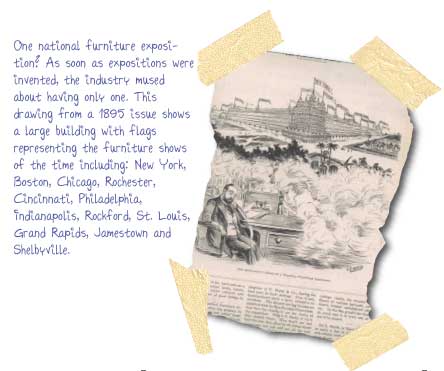
THE PANIC OF 1893
Though the utility of large scale furniture shows seems obvious from today’s perspective, in the years following 1893, this was not a foregone conclusion. The idea was a perfect solution to a logistical problem, but the timing was not perfect. That’s because the financial panic of 1893 caused an economic depression lasting through 1897. The panic was precipitated by the bankruptcy of the Reading Railroad which at the time was not deemed “too big to fail.” That event caused the demise of hundreds of banks and businesses that served the railroad. A resulting stock market crash expedited the ongoing flight of European and especially English capital, a source of “easy money” for expansion. The financial problems spread. Contributing factors leading up to the crash included the over-rapid expansion of agricultural output accompanied by high farm mortgage debt. Concurrent industrialization greatly boosted the output of goods. An oversupply of food and consumer goods including furniture deflated prices. It was a classic boom/bust cycle. Eventually the US Congress acted in response to pressure on Democrats from farming special interests, and on Republicans from mining special interests to pass two unfortunate pieces of legislation, the McKinley Tariff, a protectionist piece of legislation supporting farmers, and the Sherman Silver Act that catered to western mining interests.
The result was persistent, high unemployment accompanied by contentious strikes and the rise of the Populist and Free Silver movements. The Sherman Silver Act, and the panic of 1893 contributed to the depletion of US gold reserves. In 1895 issues of Furniture World, furniture manufacturer Charles R. Sligh, a proponent of the free silver movement conducted an ongoing debate with Eli Perkins who favored the then current gold standard. Mr. Sligh, who apparently blamed England, Easterners as well as the US Congress railed, “These financial vaporings of Eli Perkins may amuse the east, but life is too short for a western man to take them seriously.... Since 1664, England has tried by legislation and war to crush and obliterate American manufacturers. She signally failed until she procured the services of John Sherman, when she secured by corruption what she failed to accomplish by the sword...”
A May 30th, 1895 article summed up the situation by saying, “These are the times that try men’s souls. Some report a ray of light in the darkness; others openly admit that if there is a ray of light it is scarcely discernable. There must eventually come a reaction from such long continued depression.”
MARGINS SQUEEZED
Too many furniture manufacturers and excess production capacity put downward pressure on prices. Making this situation more difficult for manufacturers was the fact that furniture retailers could now go to a furniture exhibition, see lots of competitive products in one venue and negotiate prices with multiple distressed vendors in one location. This problem was addressed at the poorly attended Third Annual Convention of the National Furniture Dealers’ Association in President A.J. Conroy’s long keynote address. “Gentlemen of the National Retail Furniture Dealers’ Association,” he said, “I regret exceedingly that we have such a small gathering… I am sorry to say that this year has not been a progressive one so far as our association is concerned.... Another thing of importance to the welfare of both retailers and manufacturers: We must not try to break down the prices of the manufacturer, especially at this time when everything is too low. As long as we are satisfied that our neighbor is not buying cheaper than we are, keep the prices up. If you give the manufacturer a chance to make some money, you will put more in your own pocket. If you buy a chiffonier for $11 that you might possibly get for $19 by crowding the manufacturer down to cost, and you are doing your business properly, on a percentage basis, you will make your percentage on $1 instead of $10…. The more a manufacturer can make, the more he pays his workman. And the workman puts it in circulation. He buys more furniture for his own use… Thus by aiding the manufacture to make more money, we are selling more goods and making more money ourselves. It is a mistake to think that low prices make good times. Sustain good times by sustaining good prices.”
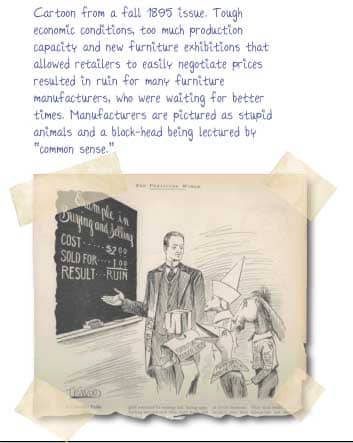
THE NEW FURNITURE EXHIBITIONS CRITICIZED
Many manufacturers blamed the new furniture exhibitions for poor business and low wholesale prices. Reps were unhappy and retailers complained about the practices of some manufacturers’ showrooms. In 1895, Simon Fish, President of the Retail Furniture Dealer’s Association of Chicago, complained about how exhibitors were bypassing retailers and selling goods direct to consumers. In the April 25th, 1895 issue he opined, “We believe that the manufacturer should confine himself, in disposing of his product; to the dealer for it is impossible for the retailer, with the expense of handling, delivering, rent, advertising etc., to exist and pay his honest debts. It was resolved (at a recent meeting) that the practice of selling furniture at retail by manufacturers was pernicious in its effect, and was a detriment to the retail trade.“ The committee of the retail association included John M. Smythe, of the John M. Smythe Co, and Adolph Karpen of Karpen Bros.
Others doubted that the new expositions would be a sustainable marketing model. In the July 4th 1895 issue, “Robert Becker, President of the Cincinnati Furniture Exchange said, “We do not want an exhibition here this summer. Expositions are not profitable to the manufacturers, and they certainly have not helped the market in the least. Our first exhibition paid because it was new and novel, but since that one they have been not good… Mr. Sextro proposed that we have a great furniture exposition, which we did. Then New York followed us and Chicago, St. Louis, Indianapolis and other cities. But the manufacturers all over the United States are opposed to them, having had all they want. We don’t want any more expositions, and we don’t want to do away with the manufacturer’s agents. In fact, we must return to the good old way of selling our goods.”
Still, despite poor exhibition traffic, and the feeling of some in the industry that exhibitions would become a relic of the past, the Cincinnati market as well as the others continued to be promoted and reported on in the pages of Furniture World.
Furniture World struck a nostalgic tone in its July 11th issue commenting on furniture shows. “When expositions are a thing of the past, as in this world of change and progress they are bound to be in time, will they be replaced by a system here by which the social element will have such good opportunities for expression as this gives us? We meet our fellow drummers out on the road occasionally, but here we meet them constantly. Before the exposition era, we knew few manufacturers except the ones for whom we travelled, and today we know them all, at least all that are worth knowing and that means all of them. The charm of meeting friends is not a small consideration to us when we are in the ‘suburbs’ of the sere and yellow. There is an air of good fellowship, a kindly greeting from old friends and new, and we pass from one exhibit to another that keeps the heart young and the spirits light, that makes the world more beautiful and brings the thought uppermost: ‘It is good to be here.’”
In the July 11th, 1895 issue a cartoon titled “The Enthusiasts Dream of A National Furniture Exposition”, was published. This was an idea repeated throughout the years in many issues of Furniture World. Depicted in the drawing (reprinted on page 24), was a large building with flags representing the furniture exhibitions of the time including, New York, Chicago, Rochester, Cincinnati, Boston, Philadelphia, Indianapolis, Rockford, St. Louis, Grand Rapids, Jamestown and Shelbyville.
The following month, travelling furniture reps published a petition to abolish furniture expositions. The petition read, “We as the traveling salesman of the different manufacturers of the furniture trade feel that the exposition held in July and January of each year is of no benefit to you or ourselves, and we ask as your representatives on the road to abolish the same, as we think by abolishing the expositions you can get better prices for your goods and a more satisfactory trade.”
Furniture World solicited additional input on the exposition question. Many responses were publised, including this one from James B. Hayes, Vice President, General Manager, Standard Folding Bed Company. “We have found by experience, that the fact of the dealers having seen our goods at the exposition has been helpful to our men on the road. We have never yet exhibited without making several new and valuable customers at the exposition. On the other hand, the fact that buyers are enabled to compare goods and prices so closely, and find salesmen over-anxious to do business, enables the buyer frequently to induce salesmen to cut prices in order to make a sale… It seems to be conceded on both sides that furniture expositions should be limited to two, or at the most three weeks, unless a permanent exposition is decided upon.”
Many more opinions for and against exhibitions were voiced in the summer issues of Furniture World as business continued to be poor throughout the year. The question of furniture exhibition buildings was resolved over time in favor of their usefulness. As transportation improved, the need for very long shows to accommodate long travel times lessened. So too, the number of shows was reduced to a more manageable number. So furniture shows survived as a viable marketing model, Furniture World Magazine became the primary information source for furniture retailers and a tale of growth, modernization and development unfolded.
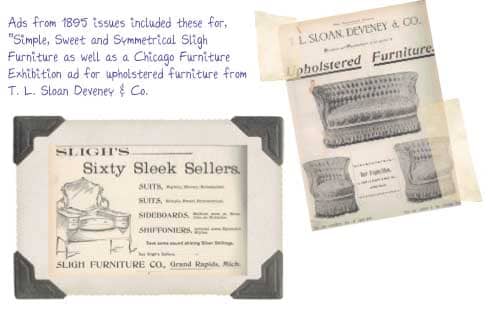
INTERESTING 1985 EDITORIAL EXCERPTS
Labor Unrest: July 11th, 1895, “The Furniture Worker’s Union, Local 6,670, K. of L., employees of carpet, furniture and bedding trade have requested the General Executive Board of the K. of L. to take action against Mason & Company and the Brooklyn Furniture Co., Brooklyn, for employing delinquent members. Districts 75 and 220 will be asked to give active support for this boycott.”
Celebrity Gossip: “Baumann Bros. have entered judgement against Pearl Eytinge, the actress, for $188.84, and unless she pays up this week her effects will be sold by the sheriff to satisfy it. Pearl has evaded service of the summons and complaint for a long time, but after several ruses were tried unsuccessfully, the process server finally put the billet in her hand while she was on the street.”
Reluctant Chicago Buyers: “The opening day, (of the Chicago Exposition), was all that could have been wished for. A heavy rain the night before laid the dust, and the air was deliciously cool and invigorating. At the building the arrangements were complete for receiving and handling visitors. There was no confusion, despite the fact that many of the exhibits were not in place… Comparatively little buying was done the past week, visitors putting in their time looking at the various lines, comparing prices and making rates. This was quite natural to expect, although it occasioned no little comment on the part of home exhibitors who were hardly prepared for so conservative a spirit.”
Jamestown Market Parade: The Celoron furniture exposition came to a close on Saturday last, and in celebration the various exhibitors and salesmen gave a parade around Celeron and then made a tour of Jamestown by electric car… July 25th, 1895.
On New Horseless Carriages: In 1895, Furniture World republished an excerpt from an article that ran in The New York Herald about a new mode of transportation. “It may be some time before the perfect horseless carriage becomes a thoroughly familiar object on our streets and highways,” the writer observed, “but it is evident that the recent race from Paris to Bordeaux and back has given an impetus to American manufacturers which could not remain long without good results.”
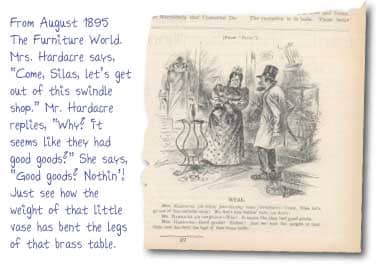
The New Woman. A Poem:
O, the Twentieth Century Girl!
What a wonderful thing she will be!
She’ll evolve from a mystical whirl
A woman unfettered and free;
No corset to crampen her waist,
No crimps to encumber her brain;
Unafraid, bifurcate, unlaced,
Like a goddess of old she will reign!
She’ll wear bloomers, a matter of course;
She will vote, not a question of doubt;
She will ride like a man on a horse;
At the club late at night she’ll stay out;
If she chances to love, she’ll propose;
To blush will be quite out of date;
She’ll discuss politics with her beaux
And outtalk her masculine mate!
She’ll be up on the science of things;
She will smoke cigarettes; she will swear,
If the servant a dunning note brings,
Or the steak isn’t served up with care.
No longer she’ll powder her nose
Or cultivate even a curl,
Nor bother with fashion or clothes,
This Twentieth Century Girl.
Her voice will be heard in the land;
She’ll dabble in matters of state;
In council her word will command,
And her whisper the laws regulate,
She will stand ‘neath her banner unfurled,
Inscribed with her principles new;
But the question is what in the world
The New Century Baby will do?
Drummer’s Lament
(Furniture Sales Rep’s Lament)
1895 Furniture World
When to a customer’s store one goes,
To beard him in his lair,
How pleasant to open the door
And find ten drummers there!
Then when it comes your turn
To have your little say,
How Pleasant to hear the remark,
“Please call some other day!”
Tips For How Retailers Should Treat Reps:
The Furniture World
- It must be remembered that the salesman is human with sensibilities equally as well as delicate as the dealer’s.
- Too much effusiveness can be as easily displayed as an undue amount of coldness, and should be avoided on the part of both buyer and seller.
- A free and easy exchange of terms and opinions in a brief and business-like manner is sufficient.
- “No” should mean “no,” but it should not be spoken so quickly unless the dealer is certain he has no use for the goods offered.
- If time can possibly be found to do so, a refusal to look at samples is a mistake, often followed by a serious regret, especially when it is found that your competitor has secured the sale of a bright, new and novel article.
- Better prices from the house than the salesman can quote is a rarity. He not only knows the lowest margin his house will accept, but is thoroughly posted on the prices of all his competitors.
Furniture Dealer Becomes Violently Insane: Arrested
1895 Furniture World
“B. Frank Wainright, furniture dealer, Asbury Park, N.J. became violently insane on the afternoon of July 3 while in a carriage in this city on his way to the Grand Central depot to take a train to Amsterdam. His fiancee, Miss Sadie F. Weaver was with him... Wainright made such a demonstration that the driver stopped and called a policeman. Miss Weaver fainted and was assisted to the St. Denis Hotel... From the police station he was taken to Jefferson Market Court. Wainright pulled a roll of bills and scattered them at the people in the room. He took a diamond ring from his finger and threw it at a court attendant... Wainright is not a drinking man and it is thought that his sudden derangement was caused by overwork.”
-July 11, 1895
Smoking Is Good For Pittsburg Residents!
1895 Furniture World
“Speaking about the ‘smoke’ nuisance, in Pittsburg coming from furniture
manufacturing plants, Robert Becker, President of the Furniture Exchange was quoted as saying, “Smoke will hurt no one, of which the city of Pittsburg is a sample, for there no one can see the sun during the week. Smoke is healthy, as it tends to drive away microbes from our city dumps and soupy asphalt streets. What we want is real good McKinley smoke coming from every plant in the city. We want to see every plant working to its full capacity, and see our working men hurrying along with their dinner pails every morning.”
Most Popular Woods
1895 Furniture World
“Mahogany continues to be the leading furniture wood. Quarter-sawed oak lumber of good quality is becoming scarce and commands about as high a price as mahogany. Natural oak, birch, elm, maple and ash are used extensively in medium and low priced goods”.
-July 18, 1895
Indictment For Connecticut Furniture Dealer Postponed
Excerpt From 1895 Furniture World
“The trial of John Mullins, furniture dealer, indicted for conspiracy and false swearing to bills in connection with furnishing the State House at Trenton, N.J., has been postponed from July 29 to September 30.”
Obnoxious Retail Ads
Excerpts From 1895 Furniture World
“A certain amount of exceedingly obnoxious advertising is being done by a few retail concerns in this city (Philadelphia), which should be frowned down. They advertise a
chamber or parlor suite at a price way below cost, and when the would-be
purchaser decides to take the goods, they say that is the last suite they had of that special shipment, and they are all sold. In passing one of the smaller stores one day, I saw a pretty birch chamber suite in the window marked to sell for $7.00, less than cost.”
Quaint Furniture Women Want To Buy
Excerpts From 1895 Furniture Worl
“Nearly every woman is now in a still hunt for quaint pieces of furniture which shall give her home an individual look. Realizing that most women abhor things that look as if they were turned out by the dozens, the most progressive dealers now only keep about half a dozen duplicates of one piece in stock. The Colonial style rages, and any women’s heart must rejoice at the beautiful pieces of
furniture shown in this style.”
Markdown Policy At Wanamaker’s
Excerpts From 1895 Furniture World
“The preparations for the annual clearing sale of the furniture department at Wanamaker’s are now going on. It is one of the chief principles of Mr. Wanamaker to allow no goods to remain long in his stores. If they do not move at the regular prices they are marked down, and a few hours after a notice of the sale is advertised sees the special bargains disappear like magic. This is one of the secrets of success of Wanamaker’s mammoth store.”